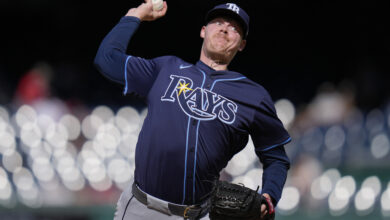Cubs Add Ross, Crowded Catching Picture Pushes Castillo Outside of the Frame
The Cubs made a flurry of moves yesterday, although depending on your level of interest in baseball you may or may not have heard of the guys they added. Shane Peterson, an outfielder from the A’s, and catcher Ryan Lavarnway from the Dodgers were claimed off waivers. To make space on the filled 40-man roster, the Cubs put Logan Watkins and Donn Roach on waivers.
But those moves are relatively minor, and guys that aren’t expected to make the Major League roster. The big move of the day was the Cubs signing David Ross to a two-year, $5 million deal. That is, as “big” a move as signing the backup catcher can be. It’s interesting for the Cubs, of course, because they already have a starter in Miguel Montero, and the previous starter Welington Castillo, is still on the roster.
But we’ll get into that in a minute. Ross is often referred to as Jon Lester’s personal caddy, and there’s an element of truth to that. I’d expect that Montero will start most of the games, and Ross will get every fifth game plus a spot start here and there. Ross is 38 years old and not much of a hitter. But that’s really not what you are looking for here. All you want in your backup catcher is decent defense, ability to handle the pitching staff, and ability to take over the starting job if Montero gets hurt.
When talking about pitch framing (a pretty big topic these days about catchers), Ross had 10.5 RAA (runs above average) last season. That puts him 13th on the list of all qualified catchers in baseball, which is headed by Montero (24.0 RAA). Castillo was second to last on that list, with -24.3 RAA. So that should make it pretty clear what the Cubs front office has been valuing highest in catchers this offseason.
I’m fairly neutral on this move. While I like the idea of adding a veteran presence, a guy Lester is comfortable with, and a guy that helps improve the Cubs pitch framing (the team was second to last in MLB last year in that category), I have other concerns. First, I really did like the idea of Montero and Castillo platooning at catcher. Montero has hit .272/.356/.442 against righties in his career and Castillo has hit .306/.373/.472 against lefties.
Montero would still get the bulk of the starts, so the pitch framing improves overall. Outside of that aspect, Castillo is still a solid defensive catcher. So the pairing worked in my mind, if you can get over the bad pitch framing twice a week when Castillo starts against a left-hander. But it appears the Cubs don’t really intend to go that route.
My other concern is injury-related. While Montero hasn’t been injury-prone in his career, per se, it’s always a concern when you’re talking about catchers who have had a knee injury in the past. Montero missed about half the 2010 season after surgery on a torn meniscus. He also missed about a month of action in 2013 with a lower back strain. These types of injuries are common among catchers.
If Montero has to miss an extended period of time for any reason, I’m not all that comfortable having a 38-year-old handling the catching duties every day. Ross’ knees have had a lot of wear and tear from a twelve-year career, and I doubt he wants that responsibility at this point. I imagine Jake Taylor from Major League when I think about how a catcher’s body holds up over the course of a long career.
Having a backup like Castillo who can step in and still provide a decent bat and experience handling all the pitchers on the staff is a better option, in my opinion. But I suppose that, in the event of injury, a guy like Lavarnway or Rafael Lopez would take Montero’s spot on the roster and get some starts to help ease the burden on Ross. But that’s not really an ideal situation for a team that’s hoping to contend for a playoff spot.
I would expect that anytime in the next week or two we can expect Castillo to be traded. I’ve seen it suggested that he could be dealt to the Phillies–who have a known interest–the Rangers, or the White Sox. All of these spots make sense, in my opinion. There should be plenty of suitors, so it’ll be interesting to see what kind of return the Cubs get for their former every-day-catcher.
Going forward, the pitch framing should really help the pitching staff. The veteran presence in the clubhouse should help as well. Hopefully, this move helps the Cubs inch ever-so-close to becoming that “real contender” they’ve told us they expect to be in 2015.

